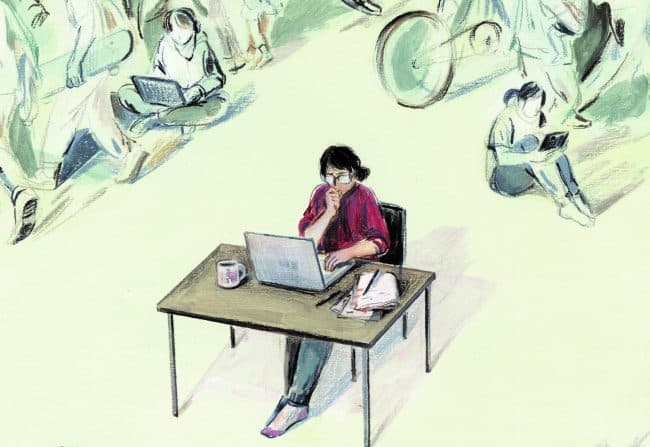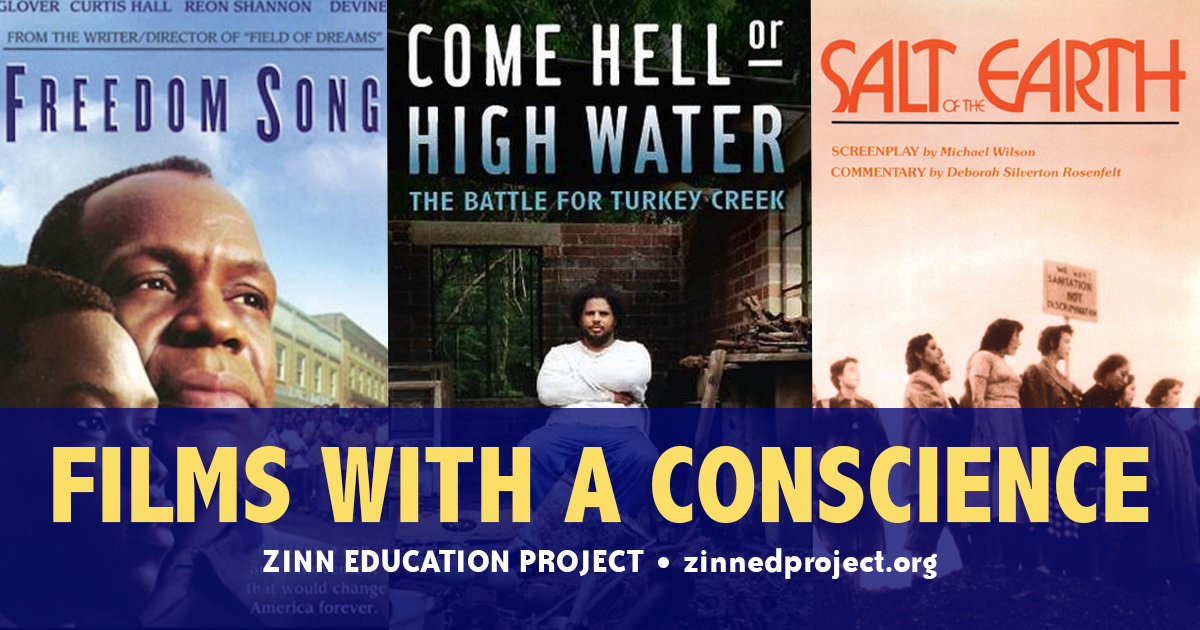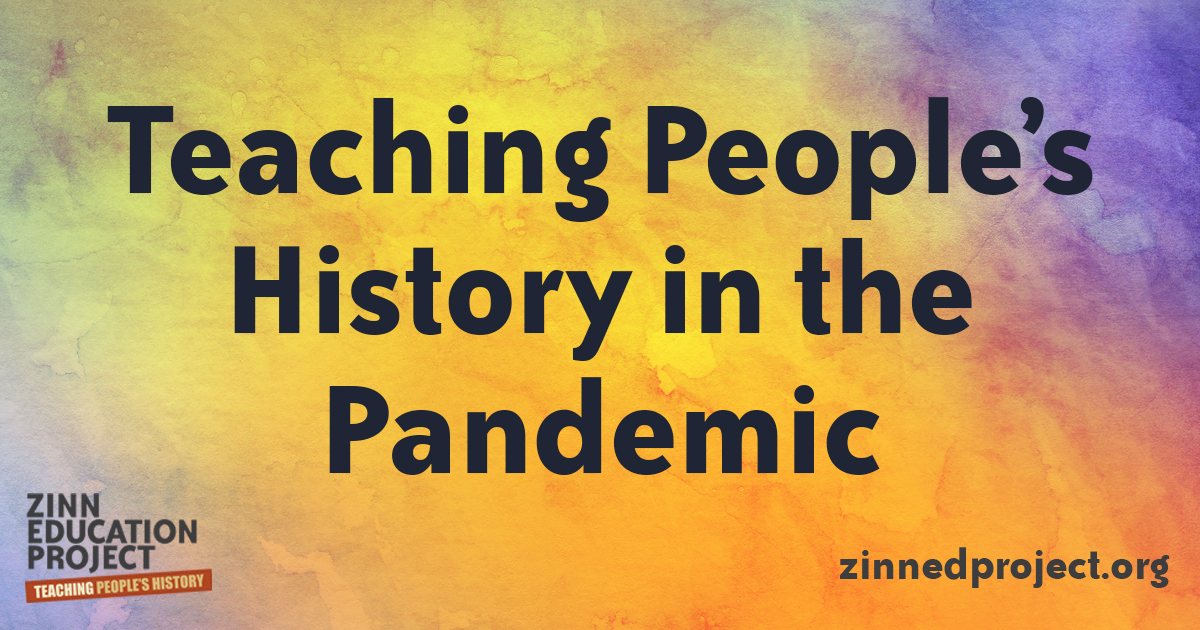By Ursula Wolfe-Rocca
March 2020 marked the beginning of a new era for teachers: teaching in the time of coronavirus. “Remote” came to describe not just how learning would be delivered, but also many teachers’ sense of efficacy and expertise — which seemed suddenly very far away, a distant memory. All those tireless hours spent decorating classrooms, carefully arranging the furniture of learning spaces, selecting the books on shelves, designing lessons, painstakingly choreographing student-centered activities, discussions, and interactions — made unexpectedly irrelevant by shuttered schools and the vacant glow of a computer screen.

Art by Sally Deng via Rethinking Schools.
Now in fall of 2020, most educators are once again meeting their students online, with a few braving an entirely new version of in-person education: physical barriers, six feet of distance, face masks and shields. No matter what the particulars of each school district’s hybrid, remote, or haltingly in-person model, many are lamenting, “We’re all first-year teachers again.” Seemingly overnight, apps have become not just add-ons for particularly techy teachers, but essential pedagogical tools for all educators. Barraged with suggestions — PearDeck! Screencastify! Jamboard! — teachers can be forgiven if they are overwhelmed.
But however we teach our lessons this year, let’s keep our focus fixed on our pedagogical and curricular values. Unifying all the lessons and resources at the Zinn Education Project is a deep belief in the power of everyday people to shape the course of history toward greater justice — that’s what we mean by “people’s history.” And to teach people’s history we need a people’s pedagogy, an approach to the classroom — online or in person — that recognizes the power of students to read the world, make meaning, and act with intention and efficacy. This “people’s pedagogy” is the yardstick by which we urge educators to measure the tech tools flooding their inboxes.
Our lessons — trials, role plays, reading, writing, viewing, and discussion activities — have at their heart a belief that students should be given opportunities to interject themselves into history, to comment and act on, not just passively receive, the past and the present. The tools — whether pencil and paper, a Zoom breakout room, or a Flipgrid video — that best safeguard those democratic opportunities are the ones we recommend.
What follows are modest suggestions — modest in two ways. First, they do not require a great deal of technological know-how and are widely available; we only suggest tools that take little time for educators to learn, are relatively intuitive for students, and are free or commonly adopted by public schools. Second, we are not experts in remote-education and we know many of you will likely surpass — creatively and ingeniously — these suggestions in your own classrooms. These recommendations are more like invitations — invitations to hold fast to your belief in the power of people’s history as you innovate, experiment, fail, learn, and discover how to teach during a pandemic.
Finally, one more invitation: Please share your experiences with us, and the larger ZEP teaching community, as we build this road together.
Please read the Zinn Education Project’s statement, “How to — and How Not to — Teach Role Plays,” before launching any role play in your classroom.
What follows is not an exhaustive list of all the lessons available at the Zinn Education Project. Although most of these suggestions are written for specific lessons, some reflect a “genre” of lesson. In that case, you will see a list of similar lessons below the featured activity. As we continue to experiment with teaching remotely, and as we hear from you about what’s working in your online classrooms, we will update this list.
The lessons with an * have the handouts prepped for remote access via Google Docs. Access the template for the handouts on the last page of the PDF of the respective lesson.
Lessons (by type) |
Suggestions/Adaptations |
| Mixer Role Plays | |
|
How Red Lines Built White Wealth: A Lesson on Housing Segregation in the 20th Century * Who Gets to Vote? Teaching About the Struggle for Voting Rights in the United States * Teaching SNCC: The Organization at the Heart of the Civil Rights Revolution * Stories from the Climate Crisis * U.S. Mexico War: “We Take Nothing by Conquest, Thank God” What We Don’t Learn About the Black Panther Party — but Should * And more mixer role plays |
Synchronous: Once students have assumed their mixer roles, have them “meet” each other in multiple rotations of Zoom Rooms or Google Meet (we recommend groups of three). If students have the capability to change their screen names, it is helpful to change it to their character’s name, so that their discussion partners can easily track who they’re talking to. Asynchronous:
Example: |
| Trial Role Plays | |
|
The People vs. Columbus, et al. Who’s to Blame? A People’s Tribunal on the Coronavirus Pandemic * Deportations on Trial: Mexican Americans During the Great Depression The Climate Crisis Trial: A Role Play on the Roots of Global Warming Hunger on Trial: An Activity on the Irish Potato Famine and Its Meaning for Today Tè Tremblé: An Unnatural Disaster: A Trial Role Play Probes the Roots of Devastation in Haiti And more trial role plays |
Synchronous: Assign each student to one of the defendant groups. Have groups write their defense in a Zoom Room or Google Meet. Also, give them a chance to draft questions they’ll want to ask the other defendants. Once everyone has written their defenses, in the full class meeting, the teacher “prosecutes” each group, then projects one defense at a time. Ask one student from the group to read it aloud, as the rest of the class reads along. Then ask other groups to ask questions of the group, either in the chat, or by unmuting. Any member of the group can answer. Asynchronous: Assign students to mixed groups (with one defendant from each indicted group) and provide all members of the group their own copy of a slide deck (like this). Each student uses one slide to write a one-paragraph defense. Each student is also responsible for reading the other defenses, asking tough questions, and replying to comments and questions made by other students on their slide. Consider having students record Flipgrid videos to share their verdicts. |
| Making Predictions | |
|
Who Gets to Vote? Teaching About the Struggle for Voting Rights in the United States * (Lesson 2 in the unit.) |
Synchronous: Students work in small group Zoom rooms or Google Meet to come up with ideas/suggestions for each situation and compare to real colonial laws/policies. Asynchronous: Students first individually jot ideas on a padlet for each situation (or build on the ideas of others). After students share their initial thinking, do a “gallery walk” of real laws and policies and/or excerpts from Chapter 2 of A People’s History of the United States (using Google Slides or jamboard), writing comments and reactions as they go. |
| Historical Dilemmas | |
|
Reconstructing the South: A Role Play * Lessons with similar formats: ‘If There Is No Struggle…’: Teaching a people’s history of the abolition movement |
Synchronous: The author of this lesson, Bill Bigelow, leads this lesson as a full class discussion, which we encourage you to try to replicate in a Zoom meeting or Google Meet since in this case, the pedagogy reflects the history. He writes, “Tell students that you will not be leading them in this activity — that, just as in the real historical moment, it was the people themselves, newly freed from slavery, who had to confront these difficult choices. Students will need not only to figure out what they think are the best answers to the questions posed in the handout, but they will also need to decide how they will discuss and resolve these.” Students may choose to “elect” a facilitator who calls on other students, to use the chat box to create a speaker’s list, or any number of other creative systems. Alternatively, you could have students work in small groups in Zoom rooms or a Google Meet to come up with proposals for each problem, scenario, and/or question. Groups might record their proposals on a Google Slide. When students return to the full class meeting, each group shares (a screen with) one of their proposals for a large-group discussion, verbally and in the chat box. Asynchronous: Students individually come up with one proposal for each problem, scenario, and/or question. They write their proposals on a Google Doc. Teacher breaks the class into six groups. Each student records a FlipGrid to share one of their proposals/answers (Ones share their proposal for the first question, twos share their proposal for the 2nd question, etc.). Students then watch and respond to at least one video on each of the six topics not including their own. |
| Creating Collective Understanding | |
| Poetry of Defiance: How the Enslaved Resisted * |
Synchronous: Assign each student one of the short readings, making sure there are relatively balanced numbers of readings from each of the seven domains. Once students have had a chance to read their selection a few times, place them in a breakout room/meet with others who read within the same domain. Ask students to share the information from their reading and gather as many different examples of enslaved people’s resistance as possible. Have students return to the large group. Next, provide each student a copy of the Poetry of Defiance Mixer Questions. Then break out students into mixed groups, with a representative of each domain. Give them time to share their expertise on each domain to answer the questions. Finally, bring everyone back. Tell students they’ll each contribute one or two lines to a collective poem on resistance and share the model “Write That I” poem described in the lesson. Create a Padlet for students to post their lines. Ask for volunteers to read the finished poem aloud to the whole group. Asynchronous: Provide each student a copy of all the mixer roles. Ask students to read a wide selection of the short readings, maybe two from each domain. Tell them they will be putting together a “found poem” about enslaved people’s resistance made up of words, phrases, and lines from these readings. So they’ll want to keep track of stories and words that they find poignant — they might use the Poetry of Defiance Mixer Questions worksheet to help them. Share with students the model “Write That I” poem described in the lesson. Ask students to write their own Write That I poem, using material from the readings they explored, and including examples from most of the domains. Ask students to post their poems ( anonymously, if you like) to a sharing platform (Google Doc/Slide or Padlet) and to comment on their peers’ poems. |
| Document-Based Lessons | |
|
COINTELPRO: Teaching the FBI’s War on the Black Freedom Movement And more document-based lessons. |
Synchronous: Like Reconstructing the South (see above), this is a lesson that transfers pretty seamlessly to an online setting. Read the first document in the set as a whole class, inviting students’ comments and questions. You might model the digital annotation process using Jamboard (or something similar). Next send students in groups of 4-5 into breakout rooms to collaboratively read (and perhaps annotate) the rest of the documents and jot down notes on the COINTELPRO Note-Taking Sheet. Asynchronously: These documents are dense and hard-to-decipher for students working alone. We do not recommend simply asking students to dive into the document set alone. As an alternative, you might assign each student only a single document, and ask them to annotate it with questions, commentary, and key ideas — like this. Once your class has collected a good variety of annotated documents, you might ask students to do a digital “gallery walk” of 8-10 other students’ documents, taking notes as they go on the COINTELPRO Note-Taking Sheet. |
Please share your experiences with us about using these adaptations and others that you create.








Twitter
Google plus
LinkedIn